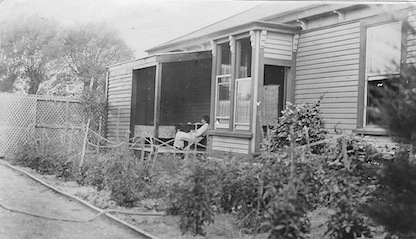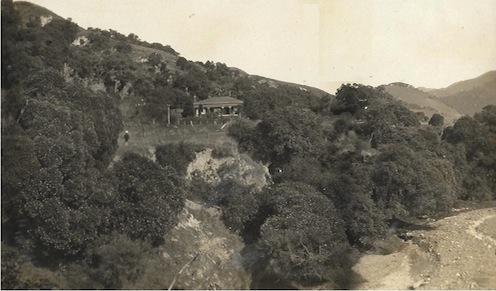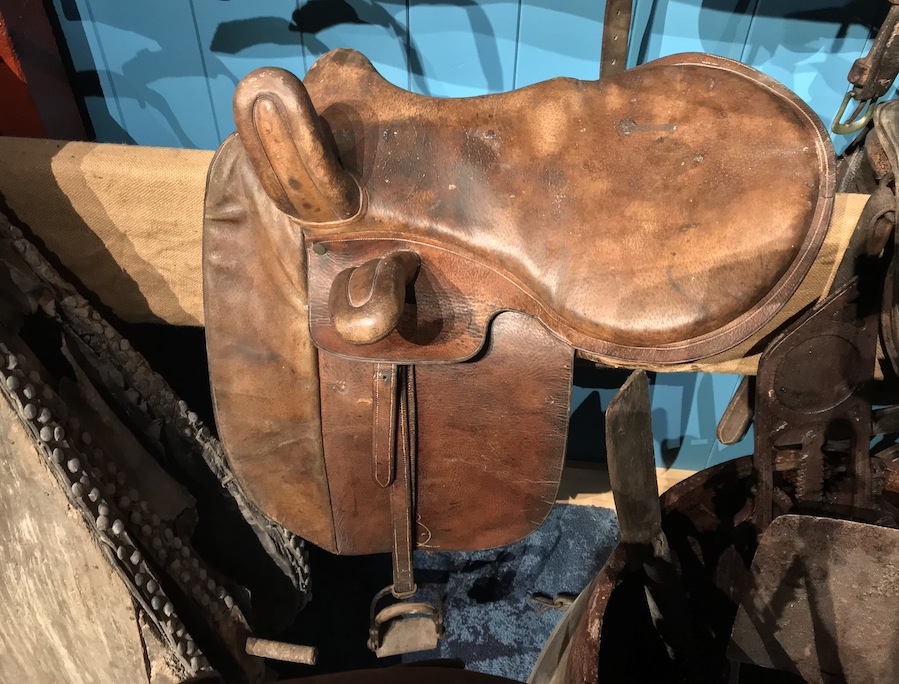Edwin was born in England and emigrated with his parents to Australia,
|
|
Edwin was sent with his brothers William and Owen to Christ's College, Christchurch. They had a good time there (according to his memoirs) with other children and adventures in town.
Most of the following is abstracted from Edwin Stanford's memoirs (see ESM). Some is taken from the memoirs of his son, Owen Stanford (OSM).
As a young man, Edwin was selected for a job with J.H.Menzies on a farm on the northern side of Banks Peninsula, to keep the son William Menzies company and to help with the work. He arrived by steamer at the wharf in Menzies Bay. He writes in his memoirs, that he had city-like manners and dress and that he was in Menzies Bay immediately immersed in country habits.
Charlotte was born in the south of the South Island of New Zealand.
One year, when Charlotte, daughter of John and Francis Menzies, came home during school vacation, she had not recovered from a persisting cold (she was frequently ill). Edwin took upon him to take care of her. Soon he fell in love with the then 13 year old Charlotte doing just what my mother had told me not to - her parting words to me being, "Now don't fall in love with any of the girls, I want you to come home and go to Oxford in a year's time when we get settled" (ESM). Falling in love was mutual. After two years at Menzies Bay Charlotte's father sent Edwin with William to the North Island to find a job there, to get Edwin away from Charlotte. John and Francis had predicted Charlotte that Edwin, when away, would soon forget her. On their way there, William told Edwin about this scheme. They nevertheless continued their trip, but Edwin "decided to not find a job" and so he returned to Menzies Bay. Still, Edwin found work at Okains Bay, west of Little Akaloa. After half a year he was summoned back, because Mr Menzies had to be in Christchurch to nurse his very ill son Stephen. On Charlotte, the effects of repeated colds was telling, she had to be sent home to Menzies Bay and Edwin again took care of her. When Charlotte (Edwin called her "Dot") had turned 19, her parents acknowledged the love and allowed Edwin to propose.
They married in 1897.
For the young couple a farm was bought, for sheep farming,
Wai-iti at Waikari north of Amberly.
It had 1800 acres for £1600.
JHM found £700 and Edwin borrowed from the Bank of NSW £900
at 6.5% interest, with the right to pay-off any sum at any time.
They married in the old wooden church in Little Akaloa.
Then the party went by steamer back to Menzies Bay.
After the meals Edwin and Charlotte went by boat to Lyttelton
where Edwin had arranged for a
special train-carriage, to be hooked onto the train to Waikari.
Charlotte and I sat in state in it, whilst it was being shunted
about at Christchurch (ESM).
Child: 1898 Owen.
Their son Owen was born in March in Ashley,
with the help of doctor Greenwood and Charlotte's mother.
In 1901 the big Cheviot earthquake (strength 6.9 at 7:47 on 16 November)
wrecked the village Parnassus
and the people there had to be housed by friends.
Around that time, Charlotte's father had to go to England to see a
specialist for his knee problem,
Edwin and Charlotte came to Menzies Bay to look after the farm there.
In that time,
Mr Menzies came to the Hawarden stock sale (a little west of Waikari)
and bought 1500 young sheep.
He, Charlotte and Owen then went to Menzies Bay
and Edwin and a drover had to take the sheep there.
It took nearly a fortnight. One sheep drowned in the Waimakariri.
Edwin and the drover had modest meals at about 1 shilling during that trip.
But in Riccarton
by mistake we went to the flash pub at the Racecourse
- had serviettes and pink glasses and all the rest at the table
and had to pay 10 shilling! .... When I arrived at the Bay with quite
a decent beard and burned brown or rather red, Owen would have
nothing to do with me (ESM).
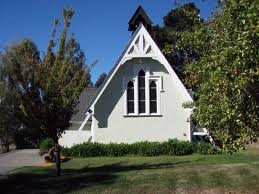
|
At that time Edwin undertook to have the parish boundaries of Amberley redrawn which included creating a separate parish with church at Waikari. Hawarden and Waikari lay in a higher wide valley, up behind the Weka-Pass. He collected the money for the build and the church could open without debt. He and Bishop Julius had the construction designed such that it would withstand earthquakes well. ESM: I insisted on casement windows which opened; so many churches seem to me so stuffy. When the foundation stone was laid he could not be there, because Charlotte was ill and he tended her and little Owen.
Charlotte was not of good health. The climate at Wai-iti was perhaps not the best, hot summer NW winds, the farmhouse on the shadow side of the hill, and the biting frosts in winter. Winds would blow very strongly from the NW, down the valley, so much so, that sometimes the train up the vally could not make it through the Weka Pass. Also, when the gates on the path down to Waikari had to be opened, Edwin had to wait for the NW to briefly blow less to open the gate against the wind. Ultimately, in 1903,

|
They relocated to Christchurch and rented a house on Pages Road, Aranui, right on the tram-line and not far from New Brighton, with just enough land to be able to keep the horse "old Peggy".
Soon thereafter they bought a farm called "Erinwood", also for sheep, at Seafield southeast of Ashburton. It was a flat place of 900 acres, oblong shaped, one mile long and 1.5 mile wide with on three sides blue gum plantation and a gum avenue to the house in the middle. Doctor Greenwood came from Amberly when needed for several days for the health of Charlotte. A son of doctor Greenwood, Gascoyne, came there to learn farming. They had no electricty, oat thresing was done with the help of a steam-tractor.
|
|
While at Erinwood, they bought a section in Christchurch
in the Cashmere Hills, with a small front on Dyers Pass Road.
A house was built and they named it Outwood
(after one of the farms of Charlottes father)
but it was poorly designed because it later
nearly collapsed on the slope.
The family of three spent the winters there,
taking Owen out of school from Seafield.
In one winter they went to Riverton for some 8 weeks,
where Charlottes mother was at that time.
In March 1907 Erinwood was sold and they lived in Cashmere for a while.
Edwin earned some extra money while working gardens and building fences.
And in 1908 Edwin and Charlotte lived in Menzies Bay to support her father
after the homestead had burned down.
Charlottes mother and her younger girls were at that time
in their rented house at Hawkesbury Avenue.
After having lived again over a year at Cashmere,
they bought the sheep farm Glen-Weem near Little Akaloa from
Charlottes brother Stephen Menzies, which Stephen wanted to sell
(Stephen relocated to the North Island).
For that, father Menzies offered to help with £1000,
because he feared Edwin might give up farming altogether.
It was a good farm, but very inaccessible.
They also had a cow.
Here, Eric Greenwood from Amberly came to work with them.
(In 1914, both Gascoyne and Eric joined the war, both died.)
Shopping was done in Little Akaloa by both Edwin and Charlotte, on horse back.
Charlotte home schooled Owen (as well as John, Willie Menzie's son).
Edwin saw that selling the land off in pieces would bring him good gains,
this was done over a few years.
|
114 Blighs Rd, 1909-1913 (from pAJnS) |
Then they returned to Cashmere Hills (the house had been let in the mean time). But Edwin did not want to return to the gardening and fencing activity. He looked for a place to have horses, decided in 1909 for 7 acres at the lower end of Blighs Road (Papanui, Christchurch), Nr. 114, which also had "glass houses" with tomatoes and grapes and a commercial apple orchard. They also bought a cow, "Bluey", which gave lots of milk. The tomatoes and grapes sold well.
In March 1913 Blighs Road was sold,
as well as a small section in Fendalton.
They rented a house in Cashmere (in Whisby Road) from Francis Thorpe,
one of the brothers in law.
Later in 1913 Edwin got restless again to go sheep farming (OSM).
Then the couple went to the North Island to find a farm,
but nothing suitable came up.
Back in Christchurch, they helped Charlotte's father
at Glen-Lyon, the farm he now ran near Tai-Tapu.
That was not always easy, because father continued to order supplies
in quantities as before, while he was now living alone.
In 1911, Charlottes father had bought a T-Ford.
And in 1913, Edwin got his licence to drive a car from Macintosh,
the only traffic cob in Christchurch.
With that car, they again visited the Butler relatives in Southland.
In that winter (the family visited and stayed in other parts of New Zealand during winters),
And then, searching further, they found a farm just inland from Oaro on the road from Cheviot to Kaikōura. Son Owen wrote (OSM p.40): "My mother went to inspect the place, liked it and it was bought", in 1914 (including 1087 sheep). Upon Owens suggestion it was named "Puke Puke" (little hills).
The furniture was packed and shipped (coastal steamer to Kaikōura, six-horse team to Oaro), and like in other moves, the furniture carved in Maori style by father Menzies suffered the usual minor breaks. Also cow Bluey moved.
|
Maori style furniture in the living room of Puke Puke
|
The farm needed a lot of "vamping up",
shifting manure, making paddocks and gardens, tree planting,
improving the hydro dam.
After the first successful wool sale (Edwin had some 1100 sheep in 1917),
"luxuries" were bought.
The house became the first in the valley with running cold and hot water.
Mrs Beaton, a high caste Maori lady, came up,
held her hand under the stream of hot water, then exclaimed:
"Well, well! I do think you born lucky-like God given you Rotorua
in your own house! Well, well!" (OSM).
The climate there had its quirks. There were severe droughts.
And the boiler limed up regularly.
But farming went generally well. There were at times 1200 sheep,
that in part broke out and grazed at the neighbours.
In about 1920, Edwin started a photo book on Puke Puke.
Also Owen had his photo book.
In these (pAJnS), there are photos of cows and sheep (as of 1922,
Owen owned sheep
himself) and of scenery. There is no photo of Charlotte.
With Puke Puke, Edwin and family finally setlled in one place
(see moves EPS).
As of 1917, the "Stanfords of Oaro" are present in newspapers.
On 30 June 1917 they donate money for Christmas for the soldiers in
"The Great War" (WW I).
On 25 April 1918, Edwin is "called to the colours".
January 1921 and 1922 Edwin is selling cattle at the Addington market.
In the mean time, son Owen is away to England and Europe
for a year (most of 1921).
And in 1923, Charlotte is donating money to an orphanage.
The cuts from these newspapers have been collected in the
clippings.
In 1922 the Christchurch
telephone directory
has an entry:
A 7114 E.P. Stanford (residential), 77 Cashmere Rd.
In 1923, Charlotte asks for a capable housekeeper for
"a Gentleman in the country";
is Charlotte now foremost in Christchurch, or does she alternate?
And in 1924 there is need for a "youth for sheep farm".
From 1926 on, only son Owen does the selling of sheep
at the large Addington market.
Sometime in the 1920s,
Edwin and Charlotte decided to adopt an orphan boy, named Peter.
He grew up on the farm and soon helped with the work.
Peter also worked on the farm Manuka Bush.
In the later 1940s
Edwin bought a farm for him in Karamea, up on the West Coast.
He moved there but seems not to have been very successful.
Aroha Pasley (nee Foster-Barham) remembers (2016):
Charlotte used to crotchet many raw wool rugs in brown
and white wool. They are still treasured by her descendants.
It is possible she gave Meta (the mother of her daughter in law)
one and encouraged her to make one too.
Owen had become a lay reader in church. Aroha:
It is possible that Owen came up to Nelson for the Angelical Synod.
Many ministers were going overseas with the troops in WW II
leaving a shortage in NZ.
I have wondered if Owen christened my sister Beatrice (born 12/10/41).
I have a vague memory of this, with a picnic christening on the lawn
at Riwaka followed by afternoon tea.
In 1934, Edwin was at the dinner for the jubilee of St. Peters church in Kaikōura (The Press, 19340924). He was seated at the "old identities" table.
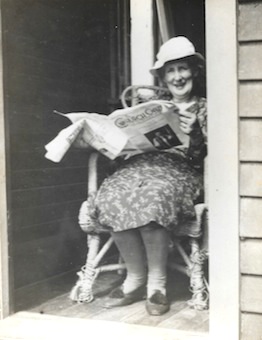
|
Charlotte reading a newspaper (ca. 1938)
at Pinecroft, the cottage of Puke Puke
(from pAJnS).
|
Edwin and Charlotte moved in 1935 onto another farm, "Manuka Bush" at Manuka Bay near Cheviot. There was a long windy road to the house. Before the move, he had a near fatal accident with his car due to the bad condition of the road, as he writes in his 1935 letter to the editor of The Press, in which he announces to be ratepayer in Cheviot soon (see the last of the clippings).
Son Owen continued the farm Puke Puke.
From Manuka Bush, they regularly visited Puke Puke staying in the cottage of the farm, "Pinecroft". And they came to help when there was illness at Puke Puke, leaving Manuka Bush to be tended by Peter. The photo, from ca. 1938, shows Charlotte in the entrance of the cottage.
Charlotte died November 1941 and was buried in Kaikōura.
She had been an avid horse rider.
The saddle she used now resides in the Kaikōura Museum.
Son Owen married Margaret Foster Barham in 1938.
Edwin often had his grandchild Aprilla stay with him so as to relieve
Owen and Margaret, who in 1942 had four children under 4 years of age.
Later he sold Manuka Bush,
and lived permanently in the cottage, "Pinecroft",
near Owen and Margaret.
He loved to take care of the grandchildren.
His granddaughter Helen (HPM2) recalls a near disastrous event.
One day there was a huge storm. Granda was in Pinecroft.
He heard a scraping noise and thought it was a possum on the roof
(he was a bit deaf).
He went out to the back kitchen.
There was an enormous slip moving towards him.
The neighbours farm had a bog which had gradually got so wet the whole
lot slid down the valley leaving it like a canyon.
The gate hung about 25' up!
Fortunately, there was a plantation at the back of Pinecroft cottage
which slewed it all sideways a bit.
But it covered the bees and water tank and knocked many big gums and
macrocarpas over.
The whole lot proceeded down past the cottage about 2 feet away
and across the main south road and down into the flooded Oaro river!
Granda would have so easily gone with it.
Mum thought it a good thing the bees had gone as
they had become too much for Granda.
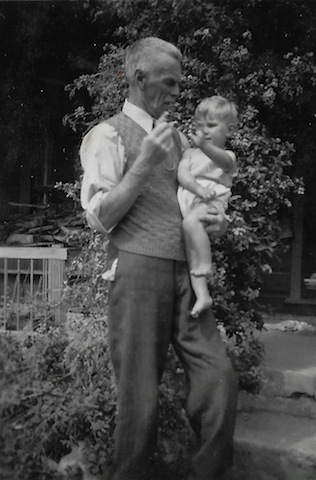
|
Granda with grandson Michael, ca. 1948. |
Edwin would also use a bedroom in the farm house. He made the morning fire, cut trees, trimmed hedges, mowed the lawn, and was generally helping. All this in spite of his limp, which he called "his gammy" (a painful knee riddled with arthritis from a rugby injury). Grandson Michael remembers: we were not allowed to sit on that knee and to sit on the other we first had to try and displace the black-and-white cat of the Laidlaws.
Edwin was a very kind man, always pleasant to the children. He did not swear but on occasion might say "damnation take a rooster".
Edwin took great interest in the well-being of son Owen and his family. The grandchildren called him "Granda". He bought the first generator for Puke Puke which gave the family much needed electricity. It was by the back door of the house and needed to be cranked. The noise the generator made was as if it said "Thank you Granda, Thank you Granda". When his grandchildren became old enough to go to school (which was 1 mile away) he bought them each a bike. He also bought the children watches.
Edwin died in 1956 at Puke Puke, aged 84, probably of a heart attack. He left each of his grandchildren £ 1000 (there was no NZ$ yet), to be given to each when they would turn 21 years old.
The information about Edwins life after 1940 has been adapted from ASM.
To the clippings.
ESM: Edwin Stanford's Memmoirs (his writing stops in 1914);
in Jacometti-Stanford archive.
OSM: Owen Stanfords memoir: "I well remember"; in
Jacometti-Stanford archive.
FMR: "Recollections of Frances Elizabeth Menzies",
ISBN 1-877242-27-6
ASM: Aprilla Jacometti née Stanford memories; in Jacometti-Stanford archive.
HPM2: Helen Perry née Stanford, "Recollections of my youth at
Puke Puke" (2017).
pAJnS: Photoarchive of Aprilla Jacometti née Stanford,
granddaughter of Edwin.
Back to the genealogy of EHS and CM.



